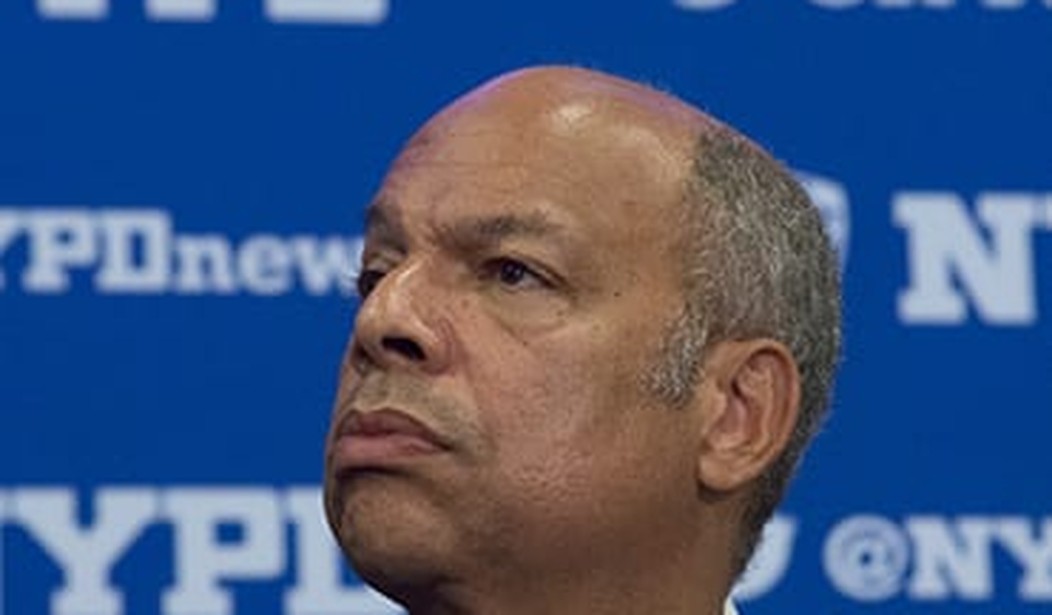If you want to get a sense of establishment political thought in the United States, you can do no better than watch NBC’s Meet the Press on Sunday mornings. Each week, host Chuck Todd interviews a selection of newsmakers (most often senators and House members), and discusses the events of the week with a panel of pundits whose positions on the political spectrum range from the center-right to the far-left. Whatever the lineup or topic under discussion, liberals always outnumber conservatives, reflecting the establishment media’s assumptions about the country itself.
And if you want to get a sense of how those establishment political figures, both pols and pundits, can talk for an hour about the news of the week without saying a word about what actually lies at the root of that news, you can do no better than watch the Meet the Press episode that aired on Sunday July 10 (video is here, transcript is here).
The news story of the week was of course the shooting in Dallas that claimed the lives of five police officers, and indeed as the show opened there appeared a clip of Dallas police chief David Brown as he spoke to reporters Friday morning. “The suspect stated he wanted to kill white people,” said Brown, “especially white officers.”
A provocative quote, certainly, one that might have led to an interesting discussion. But as the show unfolded, it was remarkable that no one, not Chuck Todd nor the people he interviewed nor the members of the panel, addressed the killer’s motives or offered an opinion on how he might have come to them. Micah Johnson, the now-deceased killer in Dallas, was never mentioned by name, and only Sen. Bob Corker spoke of him in condemnatory terms, referring to his “moral depravity.”
Any genuine discussion of friction between the police and minority communities must begin with a recognition of crime in those communities. Yet on Sunday’s Meet the Press, crime was scarcely mentioned. Only Charles Ramsey, former commissioner of the Philadelphia Police Department, mentioned the 13,000 murders that occur every year in the United States, yet he couldn’t go so far as to note that about 6,000 of those murders are committed by blacks against other blacks.
Perhaps most galling about the discussion was the way in which some of the guests seemed to draw a moral equivalence between the atrocity in Dallas and the police shootings that engendered the Black Lives Matter protest that preceded it. Asked by Chuck Todd if he was concerned about the state of race relations in America, Homeland Security Secretary Jeh Johnson struck a politically cautious but morally obtuse note. “Well, I am concerned, Chuck,” he said. “And I think at a time like this when tensions are high, in the wake of events in Dallas and Baton Rouge and Minnesota and elsewhere, it’s important to remember that just as the shooter on Thursday night is not reflective of the broader movement to bring about change in police practices, that any police officer who engages in excessive force is not representative of the larger law enforcement community, which with increasing frequency, reflects the community at large.”
Note what Johnson did there. Tensions are high, he says, because of “events” in Dallas, Baton Rouge, and Minnesota, all of which were, in his apparent opinion, equally objectionable. What rubbish.
The “event” in Baton Rouge to which Johnson refers is the fatal police shooting of Alton Sterling. At about 12:30 a.m. on July 5, Baton Rouge police officers were dispatched to the Triple S Food Mart on North Foster Drive, where a man was reported to have threatened someone with a gun. When the officers arrived, they saw Sterling in the parking lot and noted that he matched the description of the suspect aired on the radio. Portions of what followed were captured on two cellphone videos, the first of which shows one of the officers ordering Sterling to “get on the ground.” Sterling remains standing, at which point he is shot with a Taser and tackled. Neither of the videos fully depicts what happens next, but what is clear is that Sterling was lying supine but still struggling with the officers on top of him, one of whom yells, “He’s got a gun!” An officer can be heard telling Sterling, “If you f***ing move, I swear to God!” Moments later, an officer can be heard shouting, “Lake [one of the officer’s last name], he’s going for a gun!” An officer then shoots Sterling multiple times. Shortly thereafter, an officer removes what appears to be a gun from Sterling’s right-front pocket.
Contrary to Jeh Johnson’s statement of false equivalence, there is nothing in this that even suggests the police acted illegally in shooting Sterling. The officers responded to a report of an armed man and confronted the described suspect. Rather than comply with their commands, Sterling resisted and, as recorded in one officer’s excited utterance, attempted to arm himself. A question for Jeh Johnson, and anyone else who finds fault with the officers’ conduct here: What would you have them do in these circumstances?
When it comes to using force against someone, an axiom among police officers goes like this: First you ask him, then you tell him, then you make him. How quickly things proceed from one option to the next depends on the circumstances, the most important of which is whether the suspect is believed to be armed. Once a police officer establishes reasonable suspicion to detain someone, as the officers clearly did here, that person is going to be detained. The only question remaining is how much effort will be required to bring it about. Sterling, like so many others lately placed in the pantheon of the Black Lives Matter movement’s heroes, could have surrendered peacefully but chose not to.
We turn now to the “event” in Minnesota, the fatal police shooting of Philando Castile. On July 6, Castile was driving through Falcon Heights, a suburb of St. Paul. His girlfriend, Diamond Reynolds, rode in the front passenger’s seat; Reynolds’s 4-year-old daughter rode in the backseat. We know less about the Castile shooting than we do of Sterling’s in that it was not, as far as we know, captured on video. What was captured on video was the aftermath in which Reynolds, taking today’s fascination with social media to what some might call an extreme, started broadcasting live on Facebook immediately after Castile was shot, providing a narration that may or may not be accurate.
Among Reynolds’s statements to the camera is that they had been stopped for a broken tail light, a contention which, if true, would deepen the tragedy and worsen the apparent injustice of the shooting. She also says that Castile had a license to carry a firearm, and, in accordance with the officer’s instructions, was reaching for his identification when he was shot. But the officer, who appears far more distraught than Reynolds, can be heard shouting, “I told him not to reach for it!”
The video, like the ones from the Alton Sterling shooting, is indeed disturbing. We should be disturbed at watching a man bleed to death, but one’s level of disturbance is not a factor when deciding if a police shooting is justified. As in the Alton Sterling case, as in any police use of force, certain questions must be answered in rendering a judgment as to its legality. First, did the officers have reasonable suspicion to stop Castile in the first place? They did. As reported by Minneapolis-St. Paul television station KARE, the officers radioed that they were going to stop a car “to check IDs.” The officer further reported that “the two occupants just look like people that were involved in a robbery. The driver looks like one of our suspects, just ‘cause of the wide-set nose.”
The officer may have been referring to a July 2 robbery reported on the NE Minneapolis Crime Watch & Information Facebook page. The page features store surveillance photographs of a black man, one who bears at least a superficial resemblance to Castile, aiming a handgun at a store clerk in Lauderdale, another nearby suburb of St. Paul. Was Castile the robber? Apparently not, but the stop was made less than two miles down the street from where the robbery occurred, and Castile’s resemblance to the suspect was close enough, that the officers were nonetheless reasonable in the belief he may have been.
And did the officers reasonably believe Castile was armed? If we can credit Reynolds, Castile told them he was, further stating he had a license to carry a gun. Though there was some initial confusion as to whether Castile was in fact so licensed, the Minneapolis Star Tribune reported on Saturday that he did in fact have a valid gun permit.
Which brings up the question of how one should behave when stopped by the police when carrying a legal firearm. I spent some years of my police career working in an undercover assignment, an occasional consequence of which was being stopped by the police. When this happened, I rolled my windows down, kept my hands on the steering wheel, and informed the officer that I was a cop and had a weapon. I further told him where I was carrying both the gun and my police ID, and I did not dare move my hands until I was instructed to do so. I grant that I am white and middle-aged, but it behooves anyone of any race or age to behave likewise under similar circumstances. Did Castile? We have Reynolds’s assertion on the video that he was reaching for his ID as the officer had instructed. But this is countered by the officer’s statement, also on the video, that he “told him not to reach for it.”
In examining both the Sterling and Castile shootings, even if one accepts the more credible allegations against the officers, i.e., that they overreacted to slight or non-existent threats, in neither case could that overreaction be described as murder. That’s why it’s so discouraging to see these incidents lumped together with the Dallas shooting as though they were two sides of the same coin. Micah Johnson, the killer in Dallas, did not overreact in performance of a lawful duty. Motivated by his self-confessed hatred for white people in general and white police officers most especially, he set out to kill as many of them as he could. Yet the Wise Ones on Meet the Press couldn’t bring themselves to make that distinction lest they appear racially insensitive.
The Philando Castile case is less clear-cut than that of Alton Sterling, but I’m confident that none of the involved officers in either case will ever be convicted of a crime or perhaps even charged. Prosecutors who may consider charging them are surely watching events in Baltimore, where three trials of the officers accused in Freddie Gray’s death have thus far resulted in two acquittals and a mistrial. A third acquittal may come as soon as this week, to be followed by a fourth, fifth, and sixth should State’s Attorney Marilyn Mosby continue down the path she so foolishly chose last year.
What will they say on Meet the Press when that happens?










Join the conversation as a VIP Member